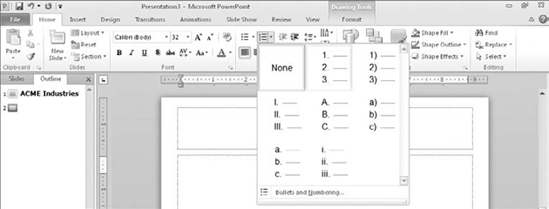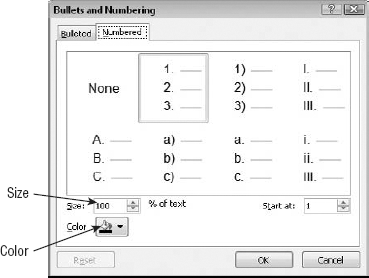Numbered lists are very similar to bulleted
ones except instead of using the same character for each item they use
sequential numbers or letters. Use a numbered list whenever the order of
the items is significant.
1. Using Numbering Presets
To switch from bullets to numbering, or to apply
numbering to text that has neither bullets nor numbering applied
already, click the Numbering button on the Home tab. This applies the
default numbering style — the one in position #1 of the presets.
Like the Bullets button, the Numbering button also has a drop-down list with seven preset formats plus None, as shown in Figure 1. You can apply any of those presets from the menu.
|
You usually don't want to apply numbering to the
slide master, because it's not the norm — bullets are. Also, the optimal
amount of space between paragraphs is often different when using
numbered lists. Consider creating a special master layout for numbered
lists and applying your number formatting to that layout in Slide Master
view.
|
|
2. Changing Number Size and Color
Numbers can have different sizes and colors in
relation to the rest of the paragraph text, just as bullets can. Using a
different size and/or color can make the numbers stand out. To change a
number's size and color, follow these steps:
Select
the paragraph(s) to affect. If you want to create a layout master to
store the numbering formatting, switch to Slide Master view and work on
that layout master.


Open
the Numbering button's menu and choose Bullets and Numbering. The
Bullets and Numbering dialog box appears with the Numbered tab
displayed.
In
the Size box, use the increment buttons to increase or decrease the
size. The size is in relation to the text size of the paragraph. See Figure 2.
Click the Color button, and select a color from the Color Picker.
Click OK to apply the changes.
NOTE
The color and size changes you make in the Bullets and Numbering dialog box affect all seven presets.
3. Changing the Start Number
To start the numbered list at some number other than 1, change the Start At value in the Bullets and Numbering dialog box (see Figure 7-7). You might do this, for example, if a numbered list continues from one slide or one text box to the next.